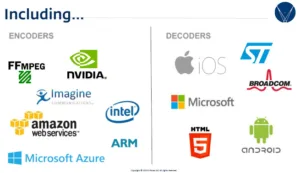 It’s two years since V-Nova, based in the UK, made a splash with its new Perseus codec a couple of years ago. As well as promising high quality at very low bit rates, the company said that its solution could use existing chips and also had quotes from a number of big companies to endorse its technology. Since then, the company has made good progress, mostly in the contribution area, although we still know key industry figures that are not entirely convinced about the technology. Now, the company has announced a V2 of the codec and we had a chance to talk to Fabio Murra of V-Nova just as the release went out.
It’s two years since V-Nova, based in the UK, made a splash with its new Perseus codec a couple of years ago. As well as promising high quality at very low bit rates, the company said that its solution could use existing chips and also had quotes from a number of big companies to endorse its technology. Since then, the company has made good progress, mostly in the contribution area, although we still know key industry figures that are not entirely convinced about the technology. Now, the company has announced a V2 of the codec and we had a chance to talk to Fabio Murra of V-Nova just as the release went out.
The main aim, rather than simply trying to squeeze down bitrates further, the aim has been to improve the quality at the kind of trigger points that broadcasters set. For example, the company has shown demos of SD video at just 100kbps, which allows the delivery of video using 2G Edge networks – important in many parts of the world and a factor in the use of the codec by FastFilmz (V-Nova Wins with Eutelsat and FastFilmz) to launch a streaming video service in India. Murra told us that Ericsson’s annual media report shows that while in the West we are getting used to 4G and high bandwidth, globally, 50% of subscribers only have 2G.
 V-Nova said that Perseus 2 has better quality
V-Nova said that Perseus 2 has better quality
The trigger levels are:
- 100 kbps, the minimum necessary to deliver mobile video to all consumers
- 300 kbps, for reliable, enjoyable HD mobile video experiences
- 1 Mbps, for monetisable full HD mobile video
- 2 Mbps, for HD IPTV programming for all xDSL users
- 6 Mbps, for UHD movie streaming at scale
- 10 Mbps, for scalable DTH/Cable UHD sports services.
A factor in the quality boost is allowing higher frame rates. Murra told us that because part of V-Nova’s technology is using the time domain in a different way from traditional codecs, this is something they are pushing.
One of the important issues for us was the use of existing chips as the V-Nova uses existing transformations but ‘in a different way’ (it is very cagey about giving out details, which is one reason for scepticism still in some quarters). The new software is said to be lighter than the last generation which not only means that the same hardware can be used for decoding, but also means that less power is needed for compression. For traditional broadcasters this is not a huge issue, but once you move to the cloud, saving power and processor capacity can be a signifcant factor. It also means that better performance can be achieved in client solutions such as web browsers. H.264 power use in compression can be improved by 30% to 50%, with HEVC said to be even better.
Lighter decoding also helps to extend decompression using scripting and HTML5.
The company has support from FFMPEG, Nvidia, Intel, Arm, Microsoft Azure, Imagine Comms and Amazon Web Services for encoding. There are decoders for Windows, iOS, Android and HTML as well as chips from STM and Broadcom.
Murra also told us that because operators are often committed to HEVC, VP9 or H.264, it is getting good traction for its ‘mezzanine’ approach of adding metadata to streams based on those codecs, rather than using the native Perseus codec. That can reduce the transmission costs compared to the non-Perseus versions, but, crucially, V-Nova told us that the use of the codec can be implemented without any change in existing workflows. The new version extends support of H.264 environments to also cover HEVC and VP9 base layers, while maintaining full compatibility with the rest of the delivery workflows, such as DRMs, streaming protocols like HLS and DASH, ad-insertion and other processes.
H.264, because of the lower costs of chips and systems compared to HEVC, is still the focus for many operators, Murra said.
Finally, one of the key applications that is being looked at hard by operators is the possibility of fitting multiple UltraHD channels onto single satellite transponders. While there is no shortage of capacity in satellite, the costs are per transponder, so that is very interesting. Murra told us that Thaicom is targeting 10-12Mbps for UltraHD at 50fps.

